When Arielle Jackson started her career at Google, one of her mentors taught her to embrace the fact that marketing is a highly tactical function. To this day, she loves sweating the small stuff — mostly because it all adds up to be big stuff. That’s how she helped home WiFi startup eero pull in $2.5 million in sales in a fortnight via a successful pre-order campaign. All the little stuff — from the details of eero’s website copy to the subtleties of its customer communications — added up. Rainmakers are known for their storm, but Jackson pays mind to each droplet.
While at Google, Jackson had spent nearly a decade marketing various products, including Gmail, Docs, Calendar and Voice. As Director of Retail Partnerships and Marketing Programs at Square, she managed distribution partnerships that put its products in 30,000 retail stores. At Cover, she led marketing and communications before Twitter acquired the startup. Since, Jackson’s set out on her own to help startups better grasp and broadcast their brands.
At First Round’s recent CEO Summit, Jackson outlined a simple, but powerful framework that she’s used with more than 30 startups to nail the purpose, position and personality of their brands. After working through these frameworks, founders have consistently remarked how it’s helped crystallize their identify and direction — and that they wish they would’ve done it sooner. Here, Jackson shares those brand marketing exercises.
First, let’s get one thing straight about brand.
It’s a bit meta, but to Jackson, branding itself could stand to be re-branded. “If the initial impressions of the founders I’ve worked with are any indication, there’s a healthy contingent of entrepreneurs out there who think anything involving brand or marketing is complete fluff and a waste of time,” says Jackson. “I’ve found that this belief often springs from a misconception: that a brand is equivalent to a logo. It’s not true. A brand is who people think you are. The more you get your marketing fundamentals in order early on, the more control you’ll have over that brand.”
Deeper than a logo, a brand draws from ideals not initiatives. “Take Volvo. Most of you immediately think ‘safety.’ That’s because Volvo has spent the better part of the last 70 years trying to own this word safety. And it’s not just pure marketing,” says Jackson. “Volvo lives, breathes and dies by safety. In the late ‘50s, before seat belts were even required in cars, they invented the 3-point safety harness that all of us wear when we drive today. Rather than patent it and use it only to make Volvo cars safer, they gave the technology away. That’s how obsessed they are with safety. The way that they market and message safety is very much in line with their product belief and their core principles as a company.”
A brand cements your position in your consumers’ minds and acts as an internal beacon for your company.
If you’re at a new company, you may only have seven months to make your mark, not 70 years’ worth of history or marketing dollars. So what do you do? “Every startup should work through three exercises,” say Jackson. “A lot of you have heard about the ‘4 Ps’ of marketing. I'm going to talk about 3 different Ps today. They are your purpose, your position and your personality.”
Purpose
Stop. Before you hire a PR agency or spend a dime on paid marketing, complete this exercise to clearly articulate your purpose. “You have to articulate it in clear and unmistakable terms. Your purpose is how you want to change the world for the better,” says Jackson. “The good news is that a lot of founders start companies with an idea of how they want to change the world for the better. But do you know it so deeply that you can you recite it? Better yet, can your entire team verbalize it in the same way you do?”
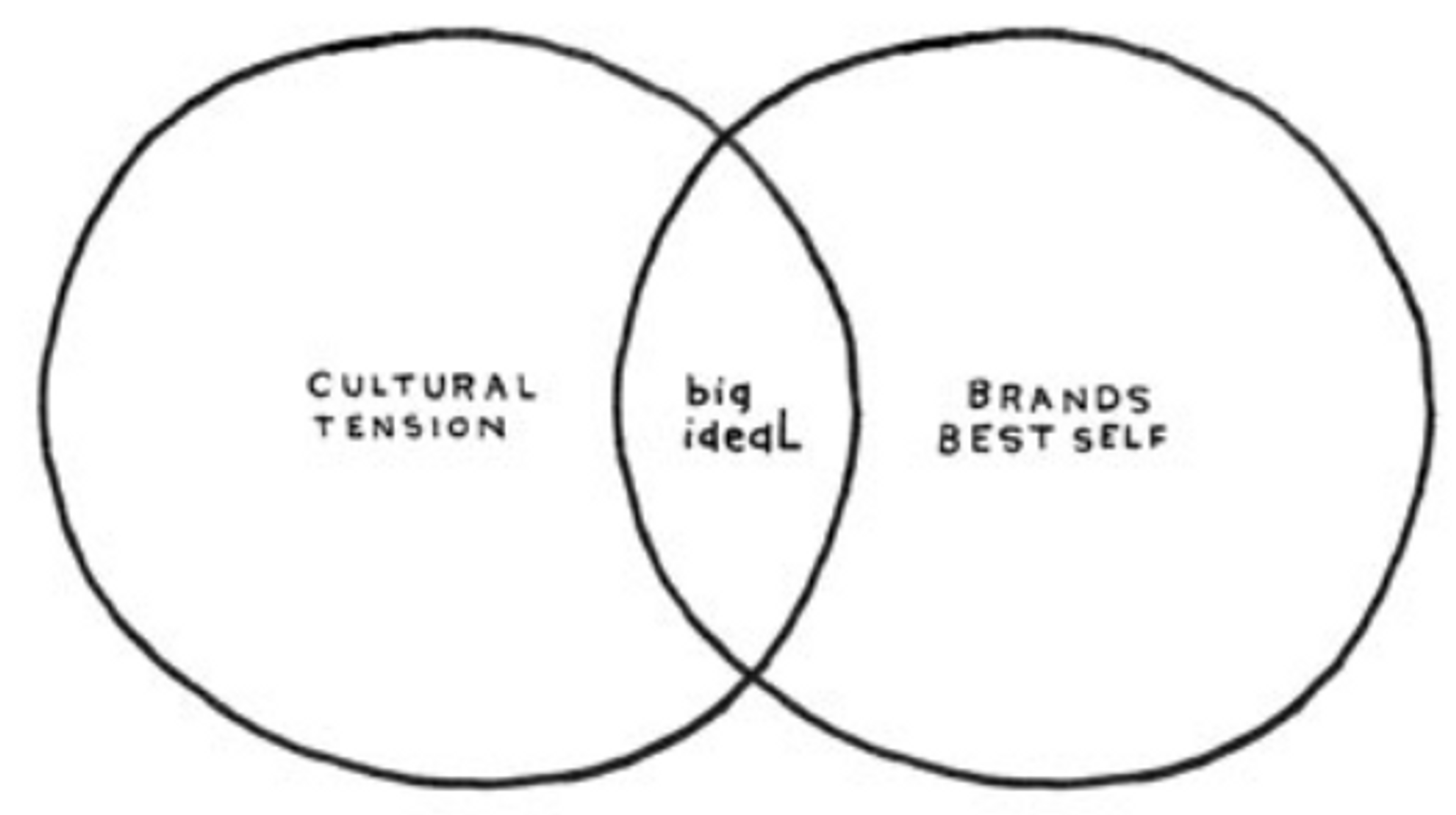
The best way Jackson has found to define purpose is through an exercise from ad agency Ogilvy & Mather called The big ideaL. “This is how the Venn diagram works. In one circle, you have cultural tension. This is what is happening in the world that’s relevant to you. In the other circle, is your brand’s best self. This is what your company delivers at its prime,” says Jackson. “The intersection of these two areas is what Ogilvy calls ‘The big ideaL’ — or your purpose.”
Start by writing down all the elements that are cultural tensions for your company, as well as list all the ways your company delivers through its products and services. Your goal is to land on one primary statement for each circle. Taken together, they should help inform how you complete the following sentence:
“For your company, the world will be a better place if ________.”
There’s a difference between answering and articulating the remainder of this sentence. “You may be able to fill in the blank, but getting these words right really can become a marketing platform for you,” says Jackson. “Let’s run through a few examples. First, Dove. The personal care brand did this exercise with Ogilvy a decade ago. They did some research and found that, in 2004, only 4% of women found themselves beautiful. That broader context helped them define their purpose.”
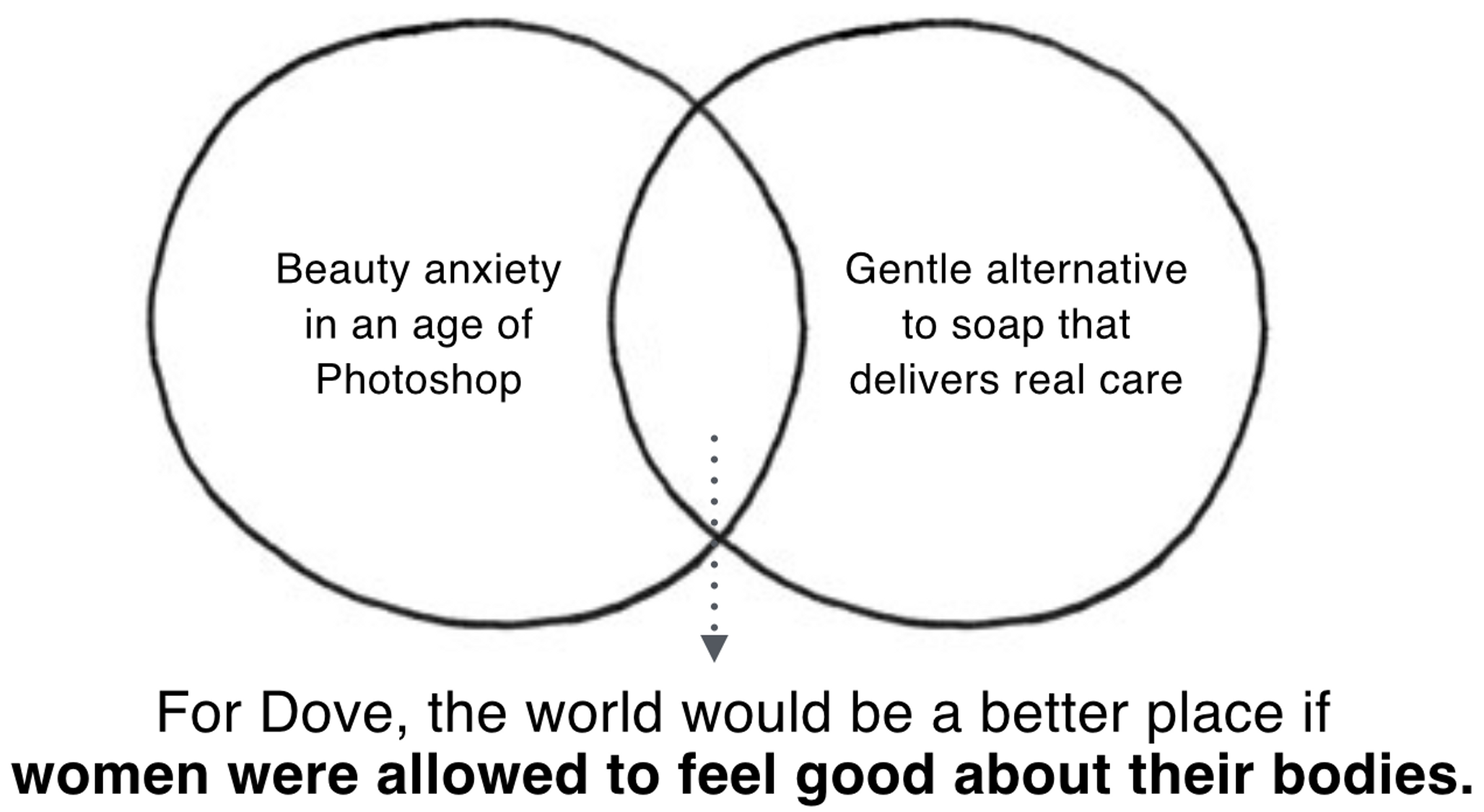
The cultural tension that Dove recognized was that women around the world had a lot of beauty anxiety. By 2004, Photoshop had become the standard tool for many magazines. This led to unattainable ideals about women’s bodies, which Dove believed contributed to women not feeling beautiful. At its best, Dove offers a gentle alternative to soap that delivers real care, particularly for women, its target audience. Brought together, Dove’s purpose became: the world would be a better place if women were allowed to feel good about their bodies.
“For the last decade, Dove has built its marketing around that one sentence. You’ve likely seen it. It’s the ‘Real Beauty’ campaign,” says Jackson. “Dove is still running it in different variations, but it always includes women of different shapes, colors and sizes, often wearing white garments, which connotes the white soap that Dove makes. Consumers now equate diverse women who are happy about their bodies with Dove soap.”
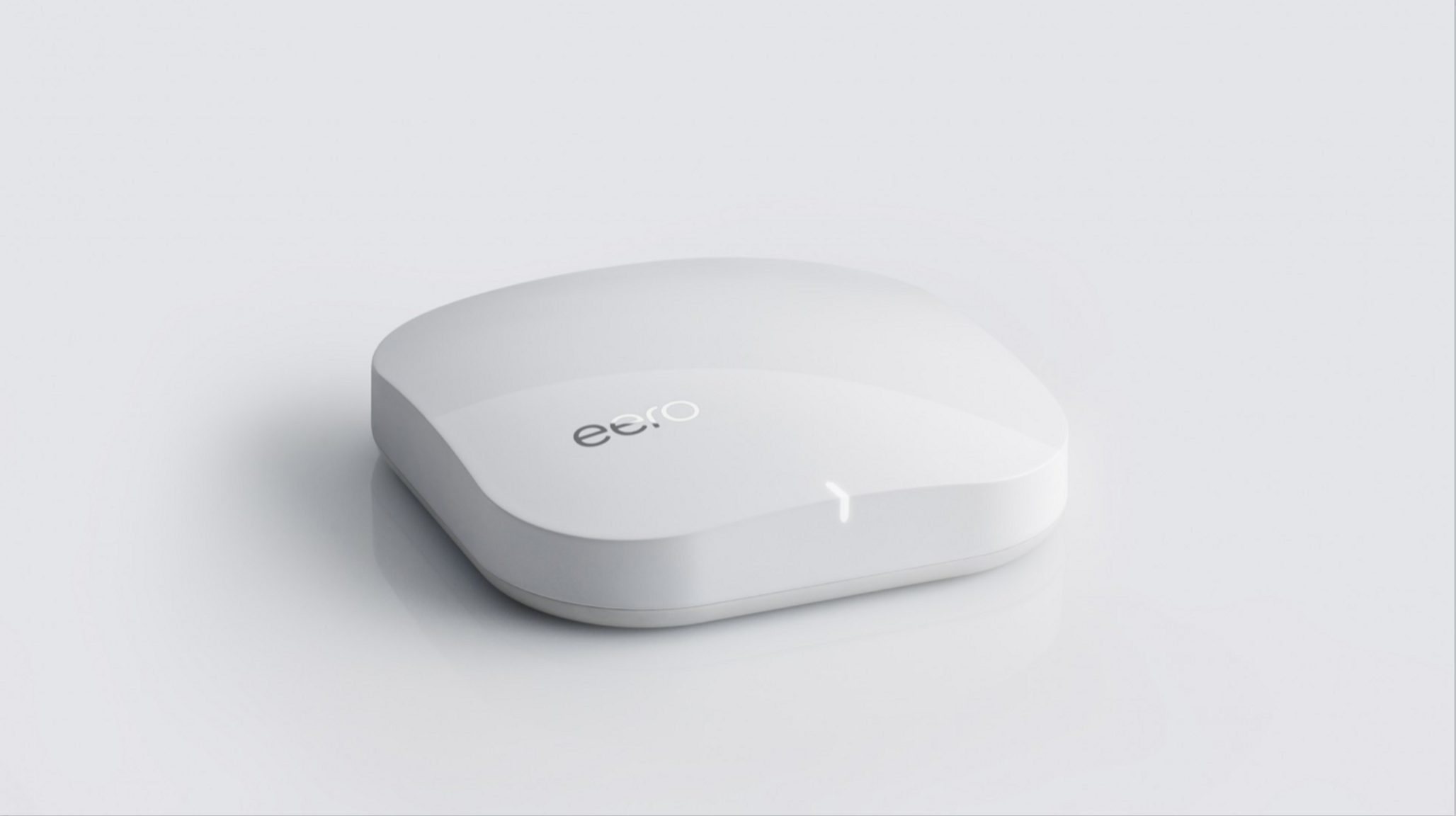
If you’re not leading marketing for a major CPG brand that sells soap, here’s an example of this exercise with an early-stage technology company. “Through an introduction from First Round, I started working with eero, a home WiFi system that blankets homes with fast, reliable internet. They replace outdated routers with something better.”
For eero, the cultural tension is that we all rely on WiFi more than ever, yet it’s still delivered via substandard technology. “WiFi has become the backbone of today’s home. We’re constantly streaming Netflix or video chatting with our grandparents. Yet, it has been neglected,” says Jackson. “The routers that we use look like something from a decade ago and they’re not held to the same standards that consumer electronics hardware is today. WiFi is death by a thousand cuts: buffering, dead zones and resetting regimens that require paper clips. There’s a lot of room both on the software and hardware side for improvements.”
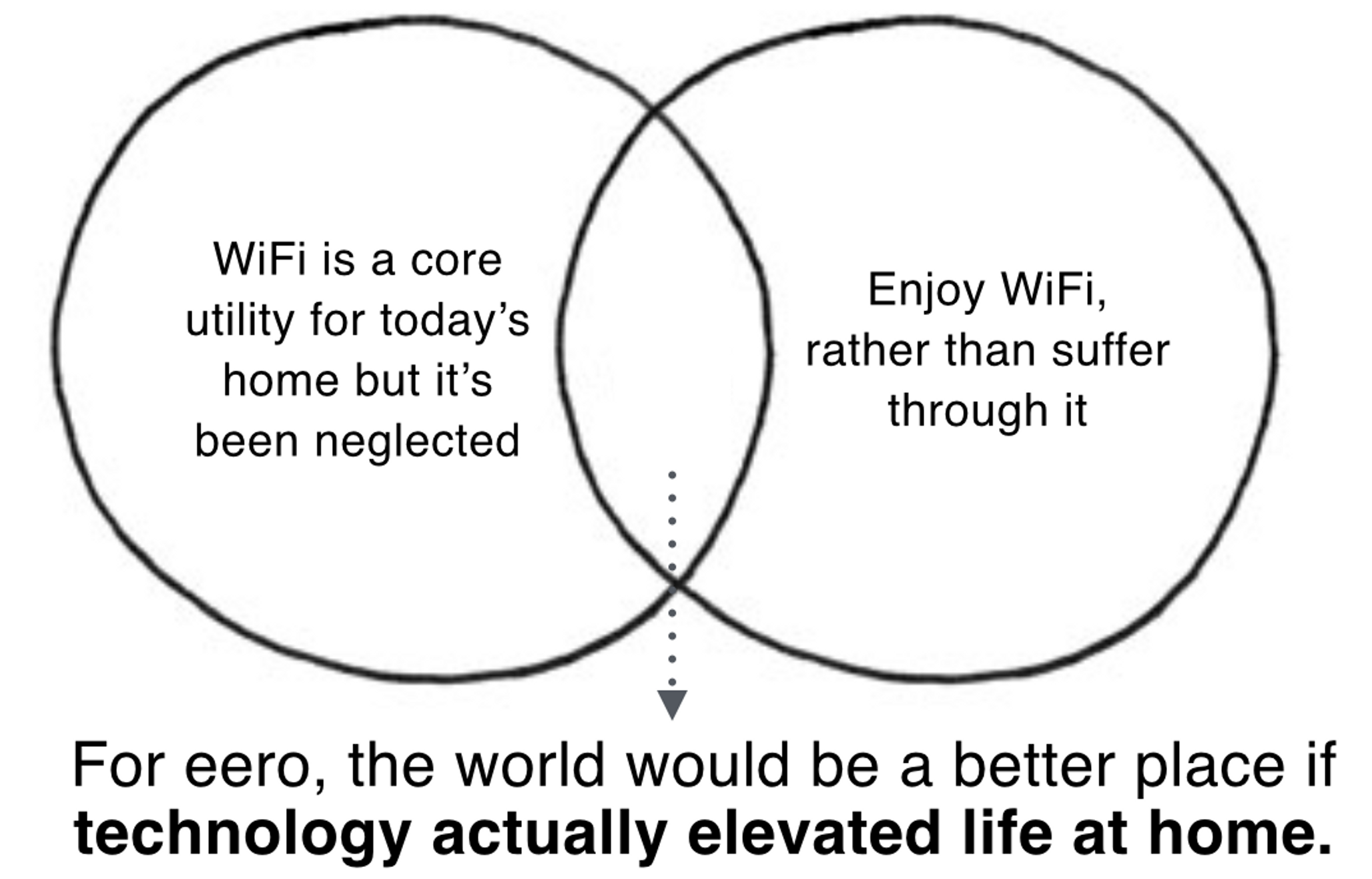
At its best, eero delivers an opportunity to remove the hassle from and bring the pleasure back to WiFi. “If you could just enjoy WiFi rather than suffer through it, your life would be so much better. That’s its promise,” says Jackson. “So, here’s eero’s purpose: The world would be a better place if technology actually elevated life at home. You’ll notice that they don’t just say ‘if WiFi elevated life at home’ because your purpose should last you at least ten years. In ten years, eero may be more than WiFi. Think years, not months with your purpose.”
Your purpose should last a decade. Not four quarters nor forever. It should be in sight, but on the horizon.
Position
No business would survive only staying in the lofty atmosphere of its purpose. You actually have to sell soap or a router replacement. “That’s where positioning comes into play,” says Jackson. “Positioning is how you’re seen in the mind of your consumer relative to something they already know. It communicates what makes you unique and different.”
As opposed to a startup’s purpose, its position should hold true for about an 18-month horizon. Whereas the company is the key factor to determining purpose, the product is the driver to establishing positioning. In practice, your position is a short statement that defines what your product is going to deliver, and how it is a better, different solution than what’s out there. Jackson has touched on this expertise in depth before, so here is the Mad Libs-inspired template to fill out for your company:
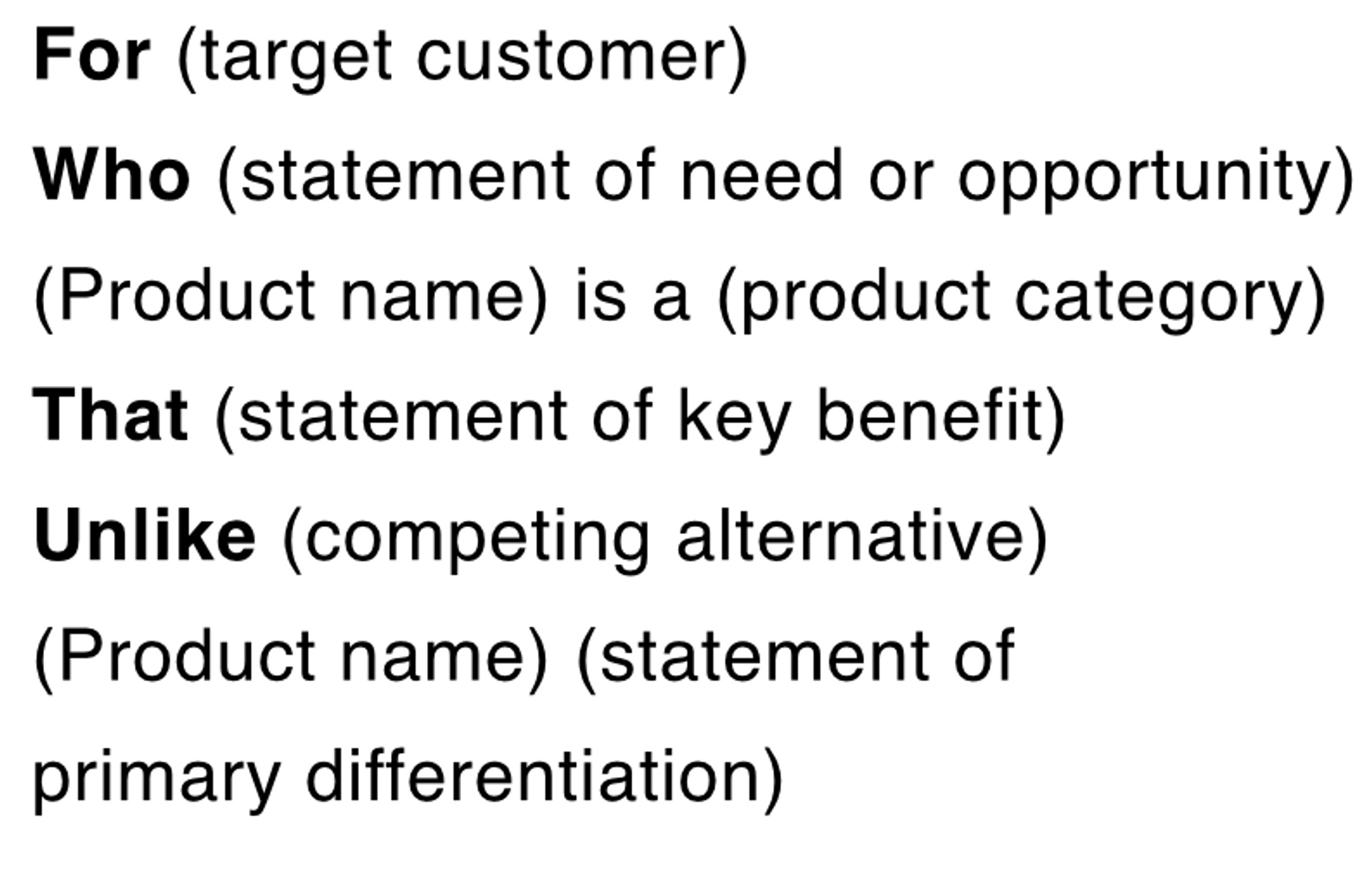
At first, this may look like a alphabet soup of abstract words and parentheses, so here are a few clarifying examples. “Let’s start with Gmail. It’s a product that’s very near and dear to my heart, as I led marketing for Gmail for three years,” says Jackson. Here is Gmail’s positioning from launch, circa April 2004:
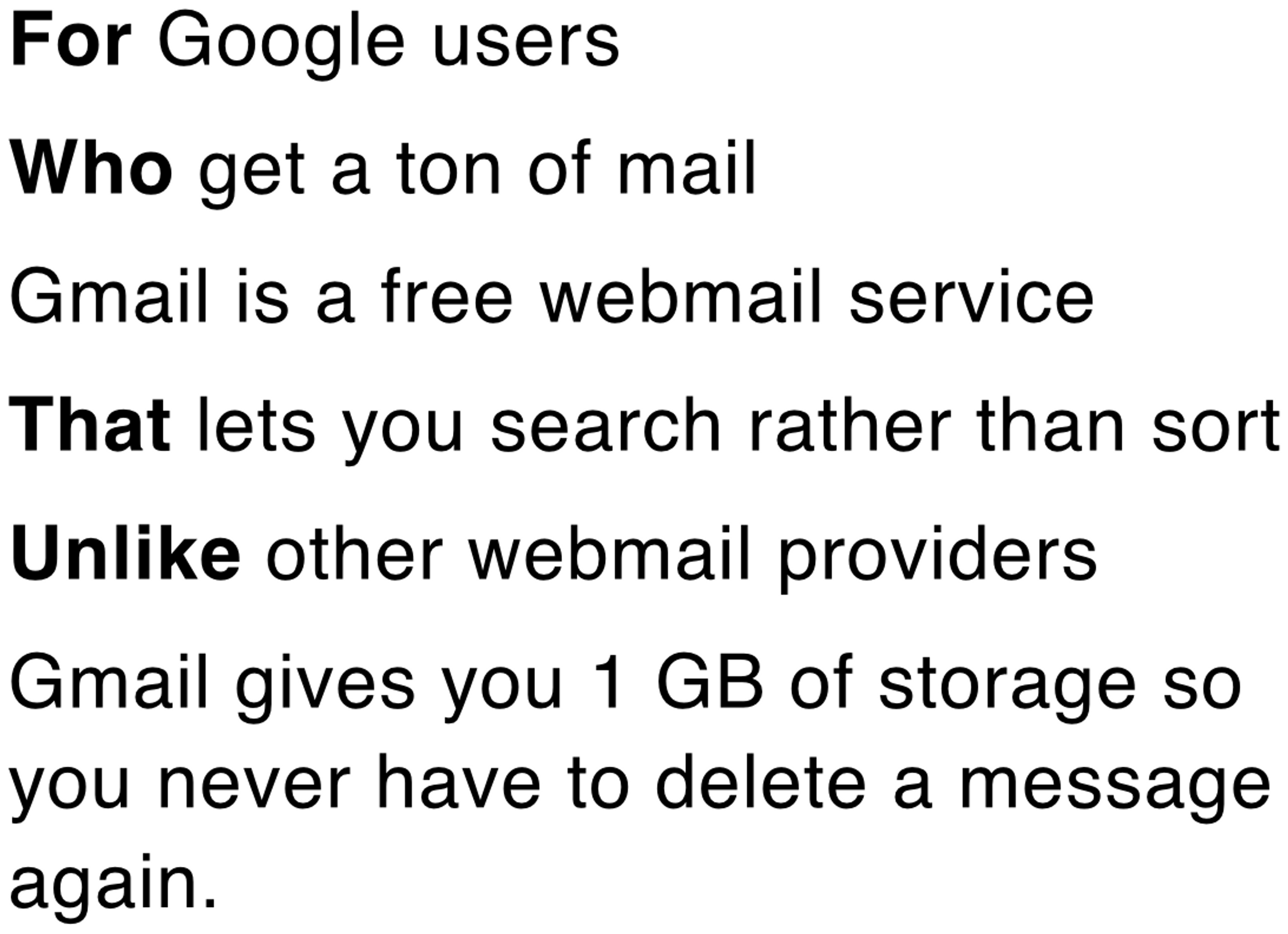
Eleven years later, the positioning statement still rings true, though the amount of allocated storage (and other bells and whistles) have changed since. For Jackson, this is a sign of good positioning. Parts of the statement can evolve about every 18 months, but it shouldn’t fluctuate entirely.
As you fill out your positioning statement, keep in mind one key distinction: the difference between the key benefit and the primary differentiation. “There can be some confusion here. Think of your benefit as the thing your best customer would tell another potential customer if they were to say why they should sign up for your product. Now your point of differentiation is your reason to believe your key benefit,” says Jackson. “For example, as an early Gmail user, I’d tell my father using AOL: ‘Dad, you’re always sorting. If you got Gmail, you could search instead of sort. That’s the key benefit. He’ll believe it because he gets a ‘gig’ of storage and it’s from Google.”
To continue with eero as a more recent example of a tech startup, here’s its positioning statement:

The helpful supplement to this exercise with eero is the context around creating it. “When I first met the eero founders and they explained their product and idea to me, it took upwards of an hour for me to get it. But in the time it takes to read this statement, most can get it now,” says Jackson. “That’s the power of the positioning statement. It isn’t often used externally. In fact, you probably haven’t seen that Gmail positioning statement verbatim on the homepage, or anywhere.”
On the flip side, this statement is invaluable to any internal or contracted team that needs to understand the product immediately and instinctively. “Let’s say you’re hiring a PR agency, a studio to make you a video or a branding firm to do your identity,” says Jackson. “Anyone you’re hiring — permanently or temporarily — who needs to understand your product very succinctly, should receive this statement before anything else. It’s the distillation of what you are, who you’re for and how you're different.”
Choosing specific words is an essential part of positioning. “In eero’s case, we did use a few of the more potent words and phrases from the the positioning statement publicly,” says Jackson. “We landed on ‘blanket your home in fast, reliable WiFi,’ and loved how ‘blanket’ sounded warm and cozy next to the very functional benefits. You’ll see this line used verbatim along with the concept of the ‘home WiFi system’ in eero’s marketing materials.”
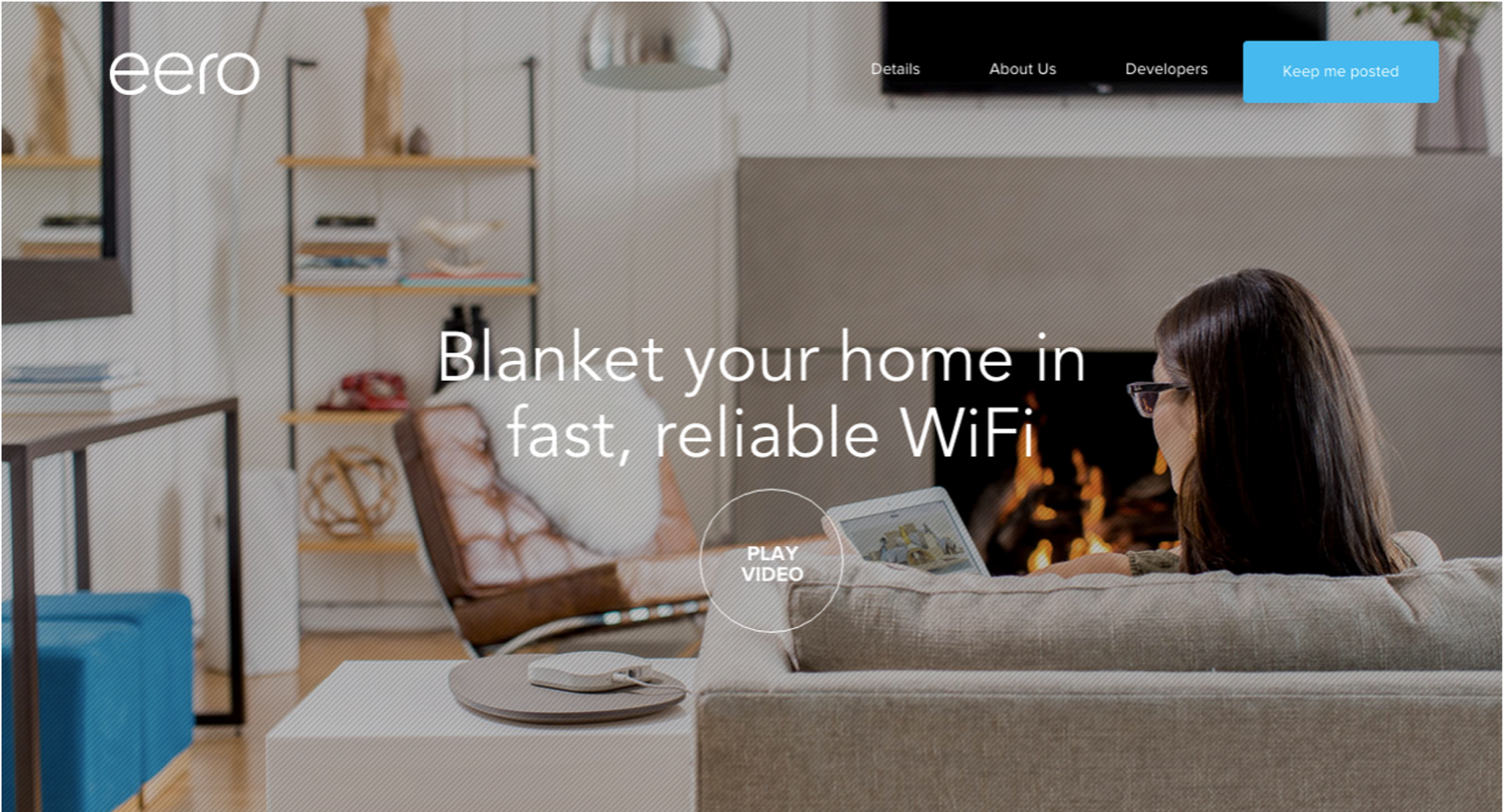
Your position is what makes you unique and different, relative to something your target audience already knows.
Personality
After defining your purpose and positioning, the last step is to identify your company’s personality. “Your personality is really what you’re like. This part is less what you say and more how you say it. It’s embedded in your voice or how you sound in written copy,” says Jackson. “Early on when you’re two guys in a garage or apartment, your startup’s personality is often a direct reflection of one or both of the founders. As you grow, it starts to become the composite of other people writing on your behalf: agencies, copywriters, community managers. More content marketing entails more material that has to be in the right voice.”
Don’t be the leader that asks copywriters to just ‘write it up.’ More often than not, you’ll be disappointed with the results. How do you ensure that anyone you hire can reflect your personality and your voice the way you want? You must pass along your company’s persona as part of the project parameters. “Ask yourself: ‘If you met your company at a party, how would you describe him or her?’ List as many adjectives as you can and then pick the top three.”
eero worked through this question with Jackson, and its words were: clever, deliberate and approachable — with ‘flawless’ as a close fourth. Then they personified eero with a short paragraph that described eero as a person. “Imagine you have a super smart architect friend who’s always flawlessly dressed, deliberate in his actions and somehow funny and approachable at the same time,” says Jackson. “Can you picture this guy? I can. He’s married to my friend in Brooklyn.”
The bottom line is if you give this short description to copywriters, they’ll channel your personality and be leagues beyond what they’d be writing if only given a jargon-laced mission statement. If you’re doing a lot of copy, take a step further and create a voice guide. Here’s how: “Take a boring sentence. Then think about one of your three adjectives. Write that same sentence completely devoid of that attribute. Then do it again, only this time take that attribute too far. Finally, write the sentence if it was infused with the perfect amount of that quality.” Here’s how the template looks:
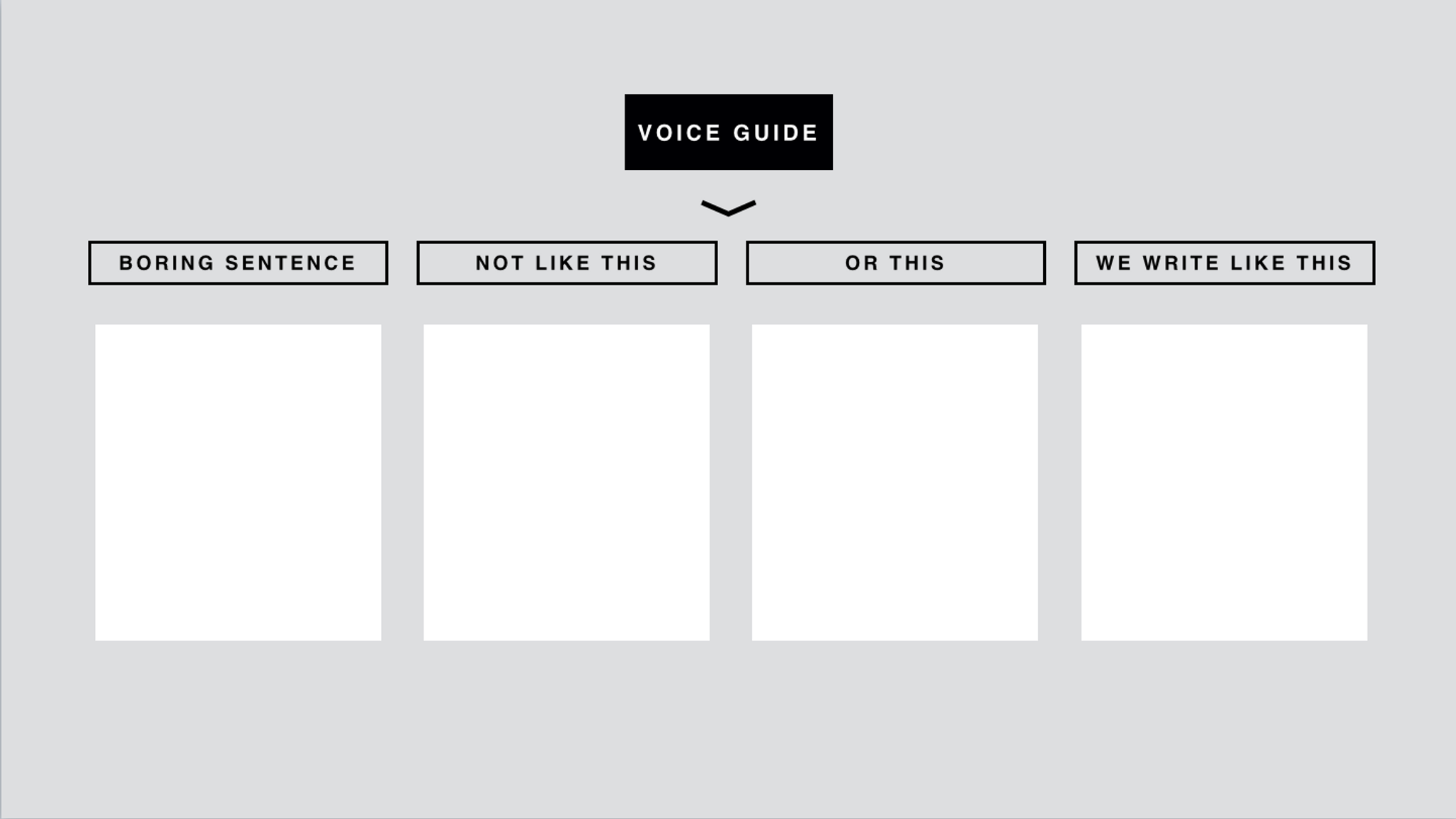
As an example, let’s fill in this voice guide for eero, applying the attribute of cleverness.

eero started with an accurate, but boring and merely functional sentence. “If you remove all the cleverness from the sentence, you could get a hyper-accurate statement with no playful wittiness, such as is listed in the second box. Or, as in the third field, produce a sentence that is taking cleverness too far and tries too hard,” says Jackson. “Both of those don’t sound like eero. In fact, the third one — “Awesome WiFi all up in your crib.” — actually undermines another top three attribute: approachability. While doing this exercise, Sean Harris, eero’s head of marketing, came up with: ‘WiFi from the window to the wall.’”
Some may recognize the reference to rapper Lil Jon’s song. That’s intentional, but not integral to understanding the statement. “What just happened? For a second, I bet you felt clever, like you were in on this joke with eero. You may have chuckled to yourself. That’s a beautiful moment. And an instantaneous connection to the brand,” says Jackson. “The real cleverness of this phrase is that, even if you don’t get the nod to Lil Jon, you still understand it. It’s WiFi from the window to the wall. It literally covers your whole home. That’s the cleverness that eero wants: it feels great if you get it, but if you don’t, it still makes perfect sense.”
The Takeaway
A brand is not a logo, a combination of hues from a color wheel or a pithy tagline. It’s the product of deep consideration of your company’s purpose, position and personality. Jackson offers a set of exercises that will help you generate a ten-year horizon for operating, your foothold in the market for the next 18 months and your personality for the duration of both. Any founding team can use these exercises to crystalize a consistent voice for those within and beyond company walls.
“These are simple, clear frameworks that can have a big impact. I’ve seen them work at all stages of startup growth. If you take one piece of advice: do these early on,” says Jackson. “If you’ve got room for another takeaway: do them periodically. A company’s brand, like its people, evolve as they develop. If you’re doing these exercises more than once, you’re growing. Revisiting your purpose, position and personality is as vital as your first articulation of them.”
